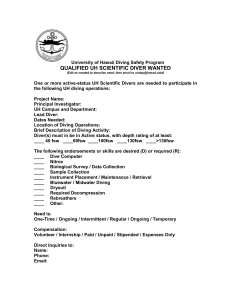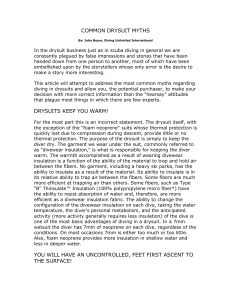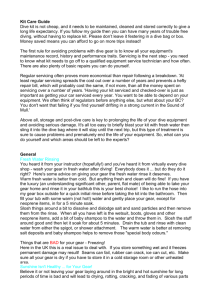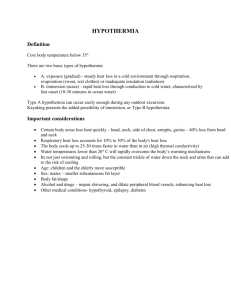TABLE OF CONTENTS - SANTI | Diving Equipment
advertisement
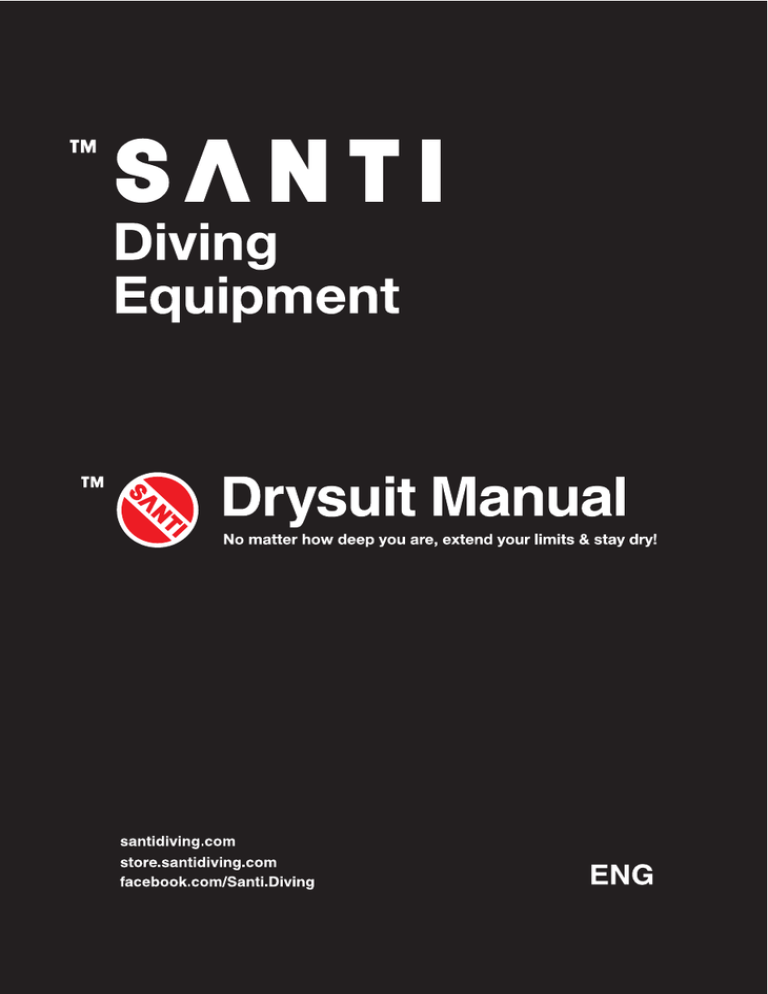
Guarantee This drysuit has been fully tested by the manufacturer. Quality control certificate attached to this product has been issued according to standard directive PN-EN 14225-2:2006. SANTI Company gives 3 years warranty on seams, fabric and workmanship for all SANTI drysuit models with the following exceptions for spare parts: • • • neck and wrist seals - 6 months of warranty from the date of purchase dry plastic zipper - 2 years warranty from the date of purchase boots, valves - 1 year warranty from the date of purchase Warranty does not cover: • • • damages made by incorrect or unwary usage consequential or accidental damage after purchase - mechanical damages and cuts damages caused by incorrect or incompetent use, incorrect storage or preservation (e.g. defects caused by: wear and tear, moisture, strong heating, using incorrect preservatives or cleaners etc.) damages caused by unauthorised alteration or repairs The guarantee card must be validated with the date and place of the purchase. Only validated guarantee card is a proof to claim any guaranty issues covered by the manufacturer. In case of guarantee claim, the cost of shipping to the SANTI Service Department is on the dealer / (client) side. After guarantee confirmation, all other costs lay on SANTI Diving Company. MAKE SURE YOUR GUARRANTY CARD IS STAMPED AND SIGNED BY THE SELLER. TABLE OF CONTENTS BASIC INFORMATION1 1.1 Manufacturer 1 1.2 Type of drysuit 1 1.3 Standard 1 1.4 List of delivered components 1 1.5 The inflation hose in attached with throttle valve for limiting air pressure 1 1.6 List of accessories and spare parts to purchase 1 1.7 Explanation of markings and pictograms1 WARNINGS 2 DRYSUIT MANUAL3 2.1 Usage 3 2.2 Construction and components of the drysuit 3 2.3 Warnings 2.4 Instruction of drysuit checking 3 6 2.5 Choice and the usage of the drysuit 6 2.6 Using drysuit during diving 11 2.7 Maintenance, service and drysuit modifications 12 2.8 Recommended control period 12 2.9 Cleaning and disinfection of the drysuit 13 2.10 Storage of the drysuit 13 2.11 Drysuit disposal 14 GUARANTEE CARD 15 BASIC INFORMATION 1.1 Manufacturer SANTI sp. z o. o. Tadeusza Wendy 7/9 WTC Expo Area PL 81-341 Gdynia Poland Tel.: +48 58 678 50 10 Fax: +48 58 678 50 09 www.santidiving.com santi@santidiving.com 1.2 Type of drysuit 1.3 Standard 1.4 List of delivered components 1.5 The inflation hose is attached with throttle valve for limiting air pressure 1.6 List of accessories and spare parts to purchase 1.7 Explanation of markings and pictograms Diving Drysuit, Type- information on page 15. PN-EN 14225-2:2006 Inflation hose, seal talcum, and zipper grease are attached to every drysuit. Additional optional components listed on the Quality Control Certificate attached to each drysuit. Detailed list of accessories and spare parts in product guide on page 5. Choice of accessories and spare parts depends on the preference of the user. Wash with water up to 400C Hand wash. Do not dry clean. Do not tumble dry. Do not iron. Do not bleach. Drip drying. SANTI DRYSUIT MANUAL 1 Congratulations to the purchase the high quality SANTI Diving Drysuit ! We know how to produce the best drysuit in the world. We keep up to date with new solutions, techniques of cutting, gluing and sewing – everything that is important in the production of clothing for divers. In SANTI we focus on comfort with an emphasis on one principle - waterproofness and the highest quality of components, which is our hallmark. That’s why all our drysuits are hand-made, with tailor’s precision. Each order is treated individually. Because every drysuit is different. Because you are special. WARNINGS ! Please read the following manual carefully before using the drysuit and keep it for future reference. All synthetic material also the drysuit fabric might cause allergic reactions. Before purchasing the drysuit, please make sure you are not allergic to the materials used in the construction of this drysuit. The diving drysuit is only intended to use by trained person, who has completed drysuit use training and possesses a certificate or is being trained by diving instructor. The usage of diving equipment by untrained person may cause health damage and even life danger. Along with an increase of depth, the thickness of the undersuit material may decrease due to hydrostatic pressure. Effect of decreased thermal insulation may occur with increased depth. Regarding the fact that the drysuit does not give 100% isolation from contact with water, diving in polluted or chemically contaminated water is absolutely forbidden. The drysuit should not be cleaned with solvents or strong detergents. Chemical substances might damage the drysuit and lead to equipment failure during diving. If any information or warning included in this manual are unclear, before usage or service of the drysuit, please contact customer service department: SANTI sp. z o. o. Tadeusza Wendy 7/9 WTC Expo Area PL 81-341 Gdynia Poland Tel.: +48 58 678 50 10 Fax: +48 58 678 50 09 www.santidiving.com 2 SANTI DRYSUIT MANUAL DRYSUIT MANUAL 2.1 Usage Maximal depth versus safety The maximum depth it is possible to dive to is limited to the diver’s knowledge and qualifications, gas mixture, thermal protection and suitable technical security. The inability of the diver to fulfil some or all of these conditions can seriously endanger health or even cause loss of life. Inflation of the drysuit with air Inflation of the drysuit with air should be done by using the attached inflation hose. The inflation hose should be connected to the bottle with air and to the inflation valve in the drysuit. The air is supplied from the bottle by the first stage regulator through the inflation valve to the inside of the drysuit. Using the button on the inflation valve and the deflation valve on the arm, the user may regulate the quantity of the air inside. Users restrictions The drysuit is intended for recreational and professional diving in both natural areas and artificial manmade containers and reservoirs. Cleanness, pH value and other elements (e.g.: chlorine) should be in a range tolerated by the human skin. The drysuit does not insulate the diver’s skin 100%, so diving in contaminated or polluted water which is harmful to the diver’s skin may well cause allergic reactions or infections as well as also damage or deform the drysuit It is necessary to comply with the principles when selecting the undersuit with regard to the water temperature and weather conditions. The drysuit helps to protect the diver from grazes and also to some degree the under-water flora and fauna. Excessive and unwary use of the drysuit will inevitably damage the material. It is necessary to return special remark on of chafing when diving on reefs, wrecks and caves. Extra patches on knees and elbows help to ensure longer suit life. 2.2 Construction and components of the drysuit Components The diving drysuit is manufactured according to the PN-EN 14225-2:2006 standard. The list of the components used in the drysuits (Page 5). 2.3 Warnings Temperature range The drysuit is capable of operating within a range of temperatures. The manufacturer suggests that thermal protection should be chosen based on following conditions: water temperature, season of the year, diving depth and level of activity under water. Temperature might influence diving comfort and diving length, in extreme situations may affect your health and safety. SANTI DRYSUIT MANUAL 3 Thermal protection Drysuit isolation depends on the right undersuit and thermal underwear selection. Lack of right thermal protection might cause thermoregulatory disorders what can cause the hyperthermia and hypothermia. Work tempo While using the drysuit the user should remember about not reaching the dangerous tempo of work activity. To avoid such level of harassment please acknowledge the following: The drysuit is designed for recreational and professional diving as well. It can be used in natural and artificial water reservoirs. Factors such as: water purity, pH, chlorine etc. should be within the range tolerated by the human skin. Drysuit does not isolate in 100% diver’s skin. Diving in contaminated waters can cause allergic reactions. Chemical contamination of water may also cause damage or deformation of the suit. Pay attention to the rules of Undersuit selection to the reservoir temperature and meteorological conditions. Drysuit protects the diver’s body against abrasion and underwater flora and fauna within a reasonable range. Excessive and careless operation may damage the drysuit material. Pay special attention to abrasions during dives on reefs, wrecks and caves. Additional patches provide longer life of the knees material. Buoyancy and depth Your buoyancy should always be neutral. You should always BCD system together with drysuit. With depth change you should control your buoyancy to avoid damage caused by the hydrostatic pressure or unexpected surface emergence. Thermal isolation and depth Thermal isolation is reduced due to hydrostatic pressure, which is increasing with depth. The user must be aware that thermal capacity of the undersuit might be reduced. Drysuit compatibility The drysuit is compatible with all standard diving equipment, such as: undersuit, mask, fins, BCD, tanks, regulator etc. The user should be trained and familiar with the use of the equipment for use with the drysuit. Enriched gases Use of any gas for inflation of the drysuit other than normal air, oxygen or argon enriched gases can cause the risk of health and equipment damage. The manufacturer suggests adequate training prior to use enriched gas. Allergic reaction Every synthetic material also the drysuit material might cause allergic reactions. Before using the drysuit, please make sure that the user is not allergic to material which the drysuit is made of, as well as the other elements included in the drysuit, such as: neck seal, neck warm and the wrist seals. 4 SANTI DRYSUIT MANUAL Drysuit components and accessories Legend: standard options custom options Model E.MOTION E.LITE ESPACE ENDURO Weight 3,2 kg 4,2 kg 4 kg 5,2 kg Fabric Ripstop Nylon/Butylene/ 2 Polyester 260 g/m Ripstop Nylon/Butylene/ Polyester 535 g/m2 Nylon/Butylene/ 2 Polyester 440 g/m Cordura/Butylene/2 Polyester 620 g/m black black/red black black black/red black black/red Colour Options Telescopic Torso black/blue black/blue yes yes yes yes front plastic zip covered with a zip-fastened flap front plastic zip covered with a zip-fastened flap front metal zip covered with a zip-fastened flap front plastic zip covered with a flap front metal zip covered with a zip-fastened flap plastic back zip front plastic zip covered Apeks Apeks Apeks Apeks SiTech SiTech SiTech SiTech Exhaust Valve Apeks low profile Apeks high profile Apeks low profile Apeks high profile Apeks low profile Apeks high profile Apeks low profile Apeks high profile SiTech SiTech SiTech SiTech Pockets 2 pockets 2 pockets 2 pockets 2 pockets Neck Seal latex with 3mm insulation neoprene latex with 2mm insulation neoprene latex with 2mm insulation neoprene latex with 2mm insulation neoprene HD bottleshape Coned Silicone HD bottleshape Coned Silicone HD bottleshape Coned Silicone HD bottleshape Coned Silicone overlapping seams, vulcanized on the inside with tape overlapping seams, vulcanized on the inside with tape overlapping seams, vulcanized on the inside with tape butt seams, vulcanized both sides with tape Standard Neoprene Boots 6mm Flexsole Standard Neoprene Boots 6mm Flexsole Standard Neoprene Boots 6mm Flexsole Standard Neoprene Boots 6mm Flexsole Neoprene Socks Neoprene Socks + Rockboots Neoprene Socks Neoprene Socks + Rockboots Neoprene Socks Neoprene Socks + Rockboots Neoprene Socks Neoprene Socks + Rockboots Zipper metal back zip Inflation Valve Wrist Seals Fabric Stitching Boots Suspenders front metal zip covered with a zip-fastened flap plastic back zip metal back zip yes yes yes yes Neoprene 9mm standard Neoprene 9mm collar Neoprene 9mm standard Neoprene 9mm collar Neoprene 9mm standard Neoprene 9mm collar Neoprene 9mm standard Neoprene 9mm collar Neoprene 9mm collar attached Neoprene 2x5 mm standard Neoprene 9mm collar attached Neoprene 2x5 mm standard Neoprene 9mm collar attached Neoprene 2x5 mm standard Neoprene 9mm collar attached Neoprene 2x5 mm standard Hood Neoprene 2x5 mm collar Neoprene 6mm standard Neoprene 6mm collar Neoprene fo full face mask - standard Neoprene fo full face mask - collar Neoprene 2x5 mm collar Neoprene 6mm standard Neoprene 6mm collar Neoprene fo full face mask - standard Neoprene fo full face mask - collar Neoprene 2x5 mm collar Neoprene 6mm standard Neoprene 6mm collar Neoprene fo full face mask - standard Neoprene fo full face mask - collar Neoprene 2x5 mm collar Neoprene 6mm standard Neoprene 6mm collar Neoprene fo full face mask - standard Neoprene fo full face mask - collar Melco Knee Pads Kevlar® Kevlar® Kevlar® Inflation hose yes yes yes yes P-Valve Halycon Halycon Halycon Halycon Rings SiTech Viking SiTech Viking SiTech Viking SiTech Viking Standard Sizes 16 mens sizes 12 ladies sizes 16 mens sizes 12 ladies sizes 16 mens sizes 16 mens sizes Made to measure yes yes yes yes Talk for the seals yes yes yes yes Lubricant for a zipper yes yes yes yes SANTI DRYSUIT MANUAL 5 2.4 Instruction of drysuit checking Prior to use Before each dive the following should be checked: • drysuit is complete and in working order, • drysuit is clean, there is no sand, insects, plant pieces or other things which may cause discomfort, • zips are not damaged and zip elements are fine. After diving After each diving, if the drysuit is dirty, you can use the following steps for cleaning and disinfection:To keep the suit clean, rinse the external part of the diving suit with clean water (especially after diving in salty water). This will remove the salt and mud from the fasteners and will limit the formation of mould, as well as the development of bacteria. Rinse with a strong stream of running water. After rinsing, dry the diving suit. Drying the diving suit is necessary in such circumstances, where the diving suit has been flooded with water. First completely dry the inside of the diving suit followed by the same procedure with the outside. When drying, the diving suit should be hung on a wide hanger with the fasteners unzipped and all other parts of the suit hanging freely Avoid drying in the sun, near chemical substances or open fire, as well as heaters, electric engines or other devices that produce ozone. The effect of these can cause color – fading and damage elements of the diving suit. After drying examine the diving suit according to the procedures given in this manual, point 2.4. 2.5 Choice and the usage of the drysuit When purchasing a drysuit the user should notice the available selection and their suitability for the type of intended diving. The drysuit is extremely universal, making it possible for use with a variety of undersuits to match a given activity. Before purchasing a drysuit it is necessary to match suitable underwear and undersuit. An ideal solution is to have an undersuit consisting of 3 layers. Because of the difference between internal and outside temperatures, dampness is condensing on the internal part of the drysuit, therefore the outside layer of the undersuit must absorb this moisture efficiently. In case of any allergic reactions due to drysuit material, please contact the doctor. Fitting of the drysuit Correct fitting of the drysuit gives much more comfort and satisfaction during use. Fitting should be carried out when wearing suitable underwear and an appropriate undersuit. Size of drysuit should be based on the information in the following table, taking the correct measurements of the indicated body parts. Santi Size Charts SANTI has in its offer a made to measure option which is done basing on the measurements given by the client. There is a possibility of small changes and modifications according to the client expectations. 6 SANTI DRYSUIT MANUAL Ladies Drysuits & Ladies Undersuits Mens Drysuits & Mens Undersuits SANTI DRYSUIT MANUAL 7 Instructions for choosing the correct size of drysuit The drysuit should be chosen according to the SANTI size chart above. It is necessary to put on an undersuit first and then put on the drysuit according to the instruction on page 10. It is important to check whether there are no loose folds, which may restrict the user movements. A correct choice of suit size ensures good thermal insulation combined with freedom of movement underwater. It is essential to choose a size that is neither too tight, nor too loose and pay strict attention to under arm measurements, which if too tight may severely restrict the diver from raising his arms. Tightness at the leg and crotch can unable the diver from drawing knees up to chest and also tightness at the chest can restrict the divers’ ability to breathe freely and cause no restricting to blood circulation. The suit should not cause stress on the neck, wrists or the diver’s face. All movements in the normal anatomical range must be executed without any resistance. All normal movements such as: bending the trunk forward, bending and stretching legs, bringing knees up to the chest, twisting and turning the trunk, and bending and stretching the arms should be possible to be made easily and without any restriction. After executing all of these movements the drysuit should always return to its original shape. All normal movements should be possible to be made easily and without any restriction. Adjustment of the neck and wrist seals All HD seals are produced in all common sizes. If it is necessary to make adjustment to the neck or wrist seal, it should be made by cutting off around the circumference and remove one of 5mm rings and then try it on again. The neck seal is conical shape, so removing one 5mm ring will slightly increase its size. Continue in this way until a satisfactory watertight fit is obtained. Ensure not to leave ragged edges when cutting as this can cause the material to split when stretched. Warning! Insufficient tightness of seal might cause its leakage. 8 SANTI DRYSUIT MANUAL Putting on the drysuit The drysuit should be chosen correctly according to the size chart to allow comfort and flexible movement. While putting the drysuit on, a detailed attention should be given to ensure that no excessive fabric is stuck in the seam or zip. Prior to putting the drysuit on, it is essential to remove watches, jewellery and other objects that may damage the drysuit. Before that it is also necessary to check whether the drysuit is complete, the legs and sleeves are arranged correctly as well as the zips. First of all it is important to check if the drysuit is not flanged on the left side, if the arrangement of the legs, sleeves and other elements is correct. The further procedures should be executed according to the following list: putting on the drysuit • • • • Each time before use, put talcum powder on the neck and wrist seals. Avoid temperatures below 0⁰C, which may damage the seals. Warm them up before use in cold conditions. Make sure that the zip is fully open. Apply the wax on the outside side of the zip and make sure the zip is clean, without any dust. Do not use silicone lubricants on the zip and rubber parts of the drysuit. Putting on the drysuit • • • • • • • • • • • • • • • • • • • Grab the drysuit with both hands and rotate the upper part of the drysuit on outside. Pic. A. Make sure that suspenders are outside your legs. You can use the drysuit bag to stand while putting the suit on. Put one of the legs in the appropriate trouser leg and after pulling the trouser part of the suit repeat that analogically for the other leg. Pic. B. Adjust the length of suspenders. Pic. D. Pull the crotch of the suit as high as possible and put on the upper part of the suit. Put on the left sleeve first and attract to the shoulder and put on the right sleeve and attract to the shoulder. Pic. E-F. Catch inside edge of the neck seal with your hands, stretch it and put on through your head. Pic. G. Lay the seal correctly around your neck. Pic. H. Place the telescoping torso: pull up the torso then wrap up the excess fabric to the pockets and fasten your crotch belt buckle. Pic. I-K. Make sure that undersuit fabric is not stuck in the zip. Close the zip carefully and completely. Pic. L. After closing the gasproof zip, close the protective zip. Check all parts of the drysuit if they match the body parts (elbows, wrists, knees, crotch are in the right place). Check the inflation valve in the following way: - open the valve completely, - bend your knees and check if the air is released through the valve. Pic M, - adjust the valve flow according to your needs. Execute movements stretching in the anatomical range. These movements should be natural not forced due to right adjustment of the suit in the maximal movement range. Connect the medium pressure hose to the inflation valve. Check the connection by pressing the valve twice. Put on the hood, gloves and the rest of the equipment. SANTI DRYSUIT MANUAL 9 Putting on the drysuit Pic. A Pic. B Pic. C Pic. D Pic. E Pic. F Pic. G Pic. H Pic. I Pic. J Pic. K Pic. L 10 SANTI DRYSUIT MANUAL Taking off the drysuit Taking off the drysuit, we start from removal of an additional equipment, such as: compass, watch ect.It will allowed the removal of the drysuit without damaging the neck and wrist seals. Then you need to proceed the following: • Disconnect the medium pressure hose with inflation valve. • Take off the hood and gloves. • Unzip completely protecting zip (concerns E.Lite model), then the gas proof one. Pic. M. Position to release air from the suit. • Detach the buckle of the crotch belt. • Catch the edge of the neck seal with all your fingers (thumbs outside). • Bend the head forward and drag the neck seal over your head. • Pull out the right sleeve first, then the left one. • Avoid catching the seals with your finger nails. • Pull down the suspenders and get off the drysuit. 2.6 Using drysuit during diving Warning! The drysuit should only be used by trained person, who has completed drysuit use training and possesses a certificate or is being trained by diving instructor recognized by the local authorities. Drysuit construction has no technical limits concerning the depth while using the drysuit. We recommend to use the drysuit at the depth in the scope of divers qualifications, gas mixture, thermal protection and suitable technical security. Buoyancy For correct and safe use of the drysuit it is essential to check the following: • • • • Prior to each dive whether the drysuit is worn correctly. Before diving the undersuit is suitable for the temperature of the water, the season and the type of diving activity. Whether the drysuit is complete and in working order. Adjustment of the appropriate ballast, equipment and adequate undersuit, equipment carried, as well as instructor’s recommendation and local regulations. Prior to each dive the appropriate ballast should be adjusted, adequate to thickness of the undersuit, including the body weight equipment carried, in accordance to diving instructor’s recommendation and local regulations. In order to keep the drysuit clean, prior to each dive wash your body and wear clean underwear. Checking of the drysuit should be done in accordance to the point about periodic inspection of this manual. SANTI DRYSUIT MANUAL 11 Diving should be done in accordance to the diving rules and regulation, internal rules of the diving organizations as well as with good diving practice. Such usage will prolong the good functioning of the drysuit and will increase the safety of the user. If it is necessary, the use of the helping line is recommended while descending and ascdending. Diving in contaminated water You should avoid usage of the drysuit especially in polluted water, or the water including chemicals or oil. The composition of some fluids may damage the drysuit. 2.7 Maintenance, service and drysuit modifications Maintenance Proper maintenance guarantees long and trouble free use of the drysuit. For every kind of repair or alteration it is necessary to consult with the SANTI service center. In the case of damage resulting from wrong use or service of the drysuit, guarantee claims will be not accepted. Minor repairs In order to ensure the drysuit will give long service and satisfaction to the user it requires constant maintenance and periodic inspections. It is possible that during the inspections outlined above the suit may occur to be damaged. Damage is usually the result of chafing on rocks, shells of crustaceans, bridges and wharfs etc. Repairs of the drysuit, valves, and other equipment, should only be carried out by an authorized service representative. Drysuit modification On customer request SANTI is able to modify or upgrade the drysuit as follows: • • • • • • • • Replacement of the wrist seals. Replacement of the neck seals. Replacement of boots including various boots. Repairs to pocket. Gluing rings. Installation of suspenders with practical pocket for documents or keys. Replacement of valves. Installation of the Apex valve in the sleeve. 2.8 Recommended control period Because of the variety of storing conditions and use, it is impossible to specify the life cycle of a drysuit. However, in order to make sure in what condition is the drysuit it is recommended to inspected and tested the drysuit at an authorised service centre, at least yearly. Periodically, at least once a year we check whether: - The drysuit is not deformed (often occurs during drying in the strong sun or close to radiators), or not damaged. 12 SANTI DRYSUIT MANUAL 2.9 Cleaning and disinfection of the drysuit Warning! For cleaning the drysuit, no solvents or strong detergents should be used. These chemicals may damage the drysuit and cause its failure when diving. After several dives, at the end of the diving trip or in case of severe contamination, it is essential to hand wash the suit using warm water with very small amount of detergent. A soft brush may be used for removing sand etc. Periodically and after every season or in justified cases (using the drysuit by more than one person) disinfection is also needed. For this purpose only a special disinfectant for drysuits should be used. It is necessary to adjust the time of exposing to the disinfectant and the concentration strictly in accordance with the manufacturers instructions. After disinfection or cleaning the drysuit should be dried in accordance to the procedure of drying stated in the section of this manual (service after diving). 2.10 Storage of the drysuit Warning! Do not store the drysuit close to electric motors or other equipment producing ozone. Time limited for storage The manufacturer is concerned about the long term and correct functioning of the product, consequently the user should follow some precautions regarding the storage. The main limitation when it comes to the usage of the drysuit is its condition. The drysuit between dives should be stored dry and hanging on a wide hanger. It is important that the drysuit is not stored folded or rolled, which may lead to long term deformation and a breakdown in the structure of the material. The place of storage should be distant from intensive sun light, chemicals, open fire and also heating devices and electrical equipment which produce ozone. These factors are liable to influence life and colours of the suit. In such condition the drysuit is not limited by the maximum shelf-life. During long periods of storage it is necessary to check twice a year whether some traces of damage are not beginning to show (seams, fastenings, material etc.). It is necessary in appropriate cases to ventilate or to change the storage environment. Manufacturer is not able to estimate the influence of ageing and usage of the drysuit on its longevity of usage, as it depends on the intensity of using the drysuit. Transport and packing the drysuit For the transport it is advised to roll the suit with special attention to ensure the zips are not having sharp bindings what could cause their damages. To avoid drysuit deformation upon folding, it should be reduced to a minimum. SANTI DRYSUIT MANUAL 13 Folding the drysuit should be done on a clean dry surface after first preparing the suit as follows: • Open the 1/4 of the zip fastening. Arrange the drysuit zip face down. • Make sure, that the drysuit is clean and dry. • Add the talcum powder on latex seals and grease the zip fasteners with paraffin wax. • When folding the suit start from the boots rolling first boots to the height of the crotch. • Roll the trunk of the suit to the height of the neck seal. • Neck seal and valves are stored under folded drysuit, and finally we fold the sleeves. • For protection we recommend transporting the drysuit in a bag supplied with the suit. Warning! Never pack the drysuit to a bag until it is completely dry. Never bend the boots. 2.11 Drysuit disposal The drysuit is made from Nylon/Cordura/Butylene/Polyester. After the suit is no longer usable, it is necessary to reprocess in accordance with local regulations regarding the disposal of objects made from rubber and synthetic substances. 14 SANTI DRYSUIT MANUAL
